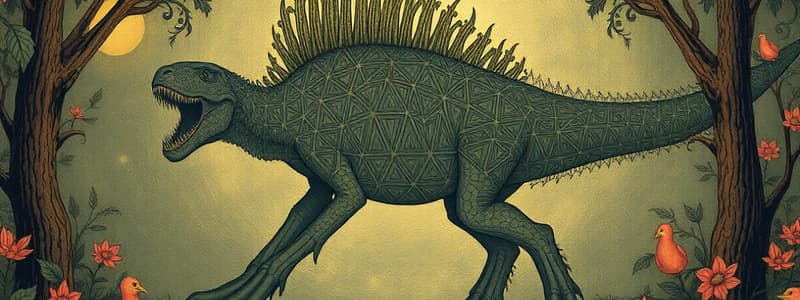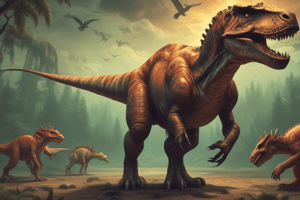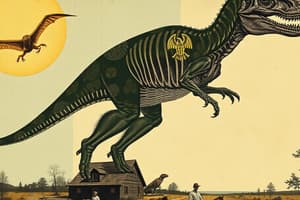Podcast
Questions and Answers
Which geological epoch saw the diversification of organisms into niches left vacant by the Cretaceous extinction?
Which geological epoch saw the diversification of organisms into niches left vacant by the Cretaceous extinction?
- Cenozoic (correct)
- Mesozoic
- Paleozoic
- Proterozoic
The Pleistocene epoch occurred entirely before the Cenozoic Era.
The Pleistocene epoch occurred entirely before the Cenozoic Era.
False (B)
What is the name given to the period encompassing both the Pleistocene and Holocene epochs?
What is the name given to the period encompassing both the Pleistocene and Holocene epochs?
Quaternary Period
The largest land mammal ever discovered is known as ______.
The largest land mammal ever discovered is known as ______.
Match each extinct animal with its modern-day relative.
Match each extinct animal with its modern-day relative.
Which of the following occurred during the Pleistocene epoch?
Which of the following occurred during the Pleistocene epoch?
The extinction of megafauna during the Pleistocene epoch was equally severe across all continents.
The extinction of megafauna during the Pleistocene epoch was equally severe across all continents.
Name one of the two main hypotheses proposed to explain the Pleistocene megafauna extinctions.
Name one of the two main hypotheses proposed to explain the Pleistocene megafauna extinctions.
The study of ancient climates is aided by analyzing ice core samples, which can go back approximately ______ years in the Arctic.
The study of ancient climates is aided by analyzing ice core samples, which can go back approximately ______ years in the Arctic.
What is the approximate temperature difference between Earth during the Last Glacial Maximum and present day?
What is the approximate temperature difference between Earth during the Last Glacial Maximum and present day?
The causes for the start and end of the Last Glacial Maximum are completely understood by scientists.
The causes for the start and end of the Last Glacial Maximum are completely understood by scientists.
After what arctic flower is the Younger Dryas named?
After what arctic flower is the Younger Dryas named?
Which of the following periods represents a warm moist interval during the late Pleistocene?
Which of the following periods represents a warm moist interval during the late Pleistocene?
The Holocene epoch began immediately after the Bølling-Allerød interstadial.
The Holocene epoch began immediately after the Bølling-Allerød interstadial.
During the Last Glacial Maximum, sea level was approximately ______ meters lower than present.
During the Last Glacial Maximum, sea level was approximately ______ meters lower than present.
Match the following time periods with their approximate dates:
Match the following time periods with their approximate dates:
Which technological advancement has significantly contributed to the study of past climates during the Quaternary period?
Which technological advancement has significantly contributed to the study of past climates during the Quaternary period?
Increased technological sophistication plays no role in understanding the Quaternary/Pleistocene extinction event.
Increased technological sophistication plays no role in understanding the Quaternary/Pleistocene extinction event.
What orbital dynamics are potentially related to both the start and end of the Last Glacial Maximum?
What orbital dynamics are potentially related to both the start and end of the Last Glacial Maximum?
The K-Pg mass extinction took place at the end of the ______ period.
The K-Pg mass extinction took place at the end of the ______ period.
Which of the following is considered a 'giant lizard' that existed during the megafauna period?
Which of the following is considered a 'giant lizard' that existed during the megafauna period?
The 'big 5' mass extinctions all occurred in the Cenozoic Era.
The 'big 5' mass extinctions all occurred in the Cenozoic Era.
What is one example of a giant marsupial species that existed during the time of megafauna?
What is one example of a giant marsupial species that existed during the time of megafauna?
Arctodus (the giant short-faced bear) existed from approximately 2.5 mya – ______ ya
Arctodus (the giant short-faced bear) existed from approximately 2.5 mya – ______ ya
Match the animal groups with a species that exemplifies gigantism during the Cenozoic Era.
Match the animal groups with a species that exemplifies gigantism during the Cenozoic Era.
Flashcards
Quaternary Period
Quaternary Period
The most recent parts of the Cenozoic Era, spanning from 2.6 million years ago to the present.
K-Pg Extinction
K-Pg Extinction
An extinction event that occurred at the end of the Cretaceous period, 65 million years ago, wiping out most large vertebrates.
Pleistocene Epoch
Pleistocene Epoch
The period from 2.6 million years ago to 12,000 years ago, characterized by significant climate fluctuations and megafauna.
Holocene Epoch
Holocene Epoch
Signup and view all the flashcards
Paraceratherium
Paraceratherium
Signup and view all the flashcards
Arctodus
Arctodus
Signup and view all the flashcards
Smilodon
Smilodon
Signup and view all the flashcards
Phorusrhachidae
Phorusrhachidae
Signup and view all the flashcards
Diprotodon
Diprotodon
Signup and view all the flashcards
Megalania
Megalania
Signup and view all the flashcards
Pleistocene Extinctions
Pleistocene Extinctions
Signup and view all the flashcards
Human-Caused Extinction
Human-Caused Extinction
Signup and view all the flashcards
Climate-Caused Extinction
Climate-Caused Extinction
Signup and view all the flashcards
Last Glacial Maximum (LGM)
Last Glacial Maximum (LGM)
Signup and view all the flashcards
Bølling-Allerød Interstadial
Bølling-Allerød Interstadial
Signup and view all the flashcards
Younger Dryas
Younger Dryas
Signup and view all the flashcards
Study Notes
- Learning objectives include recognizing trends in body size and functional diversity of large vertebrates since the Cretaceous extinction, explaining evidence informing the investigation into the Pleistocene megafaunal extinction, and contrasting the main competing hypotheses (human-caused vs. climate-caused).
Extinction Through Time
- The last mass extinction occurred at the end of the Cretaceous period, 65 million years ago.
- A more recent extinction event affected only large land vertebrates.
- The "big 5" mass extinctions all occurred in the Paleozoic and Mesozoic Eras.
- The Cenozoic Era began after the K-T (or K-Pg) mass extinction (65 Ma – present).
- The Pleistocene (2.6 mya – 12,000 ya) and the Holocene (12,000 ya – present) are the most recent parts of the Cenozoic, often lumped together as the Quaternary period.
- The Cretaceous Extinction killed nearly all large vertebrates.
- After the Cretaceous Extinction organisms diversified and began filling similar niches.
- The largest land mammal ever was Paraceratherium (34 Mya - 23Mya), a relative of rhinos that was as tall as a giraffe.
- Giant carnivores like Arctodus and Smilodon existed around 2.5 mya – 10,000 ya.
- Phorusrhachidae were giant birds that existed ~40 mya – 100,000 ya.
- Diprotodon was a giant marsupial that existed ~1.5 mya – 40,000 ya.
- Megalania was a giant lizard that existed ~1.5 mya – 50,000 ya.
Pleistocene Extinctions
- In the Americas, all mammals >1000 kg (and most >100 kg) went extinct during the Pleistocene.
- The extinction event was much less severe in Africa.
- The Quaternary/Pleistocene extinction event may be linked to humans or climate.
- Increased technological sophistication plays a role in understanding this event.
- The two main hypotheses for the Pleistocene megafauna extinctions are human cause and climate change.
- Studying ancient climates from ice core samples is a technological advancement that can go back ~100,000 years in the Arctic and nearly 1,000,000 in parts of Antarctica.
- Relevant climate events include the Last Glacial Maximum (LGM) from 31,000 to 16,000 years ago, the Bølling-Allerød interstadial (a warm moist period) from 14,690 to 12,890 years ago, and the Younger Dryas (a cold period) from 12,900 to 11,700 years ago (start of the Holocene).
- During the Last Glacial Maximum (~20,000 ya), the Earth was ~6°C colder than present, and sea level was ~100 m lower.
- The exact causes for the LGM are not entirely clear, but are probably related to long-term cycles in Earth’s orbital dynamics and potentially shifts in ocean currents.
- The Younger Dryas is named after abundant fossils of the arctic flower Dryas octopetalum.
Studying That Suits You
Use AI to generate personalized quizzes and flashcards to suit your learning preferences.




